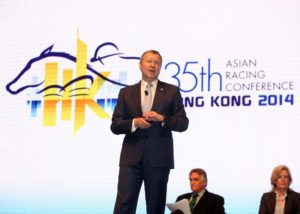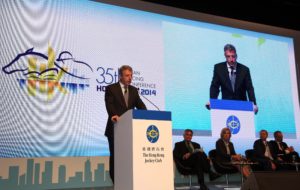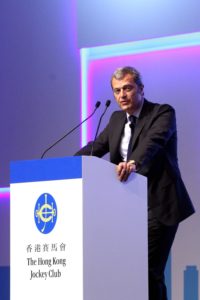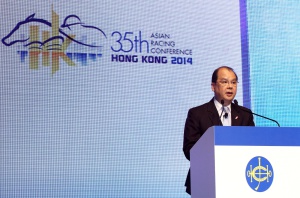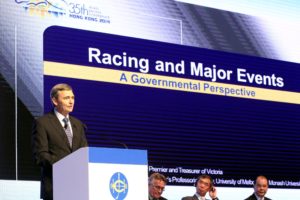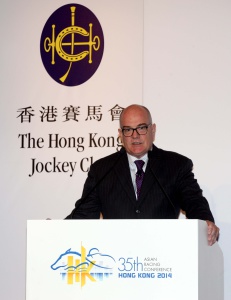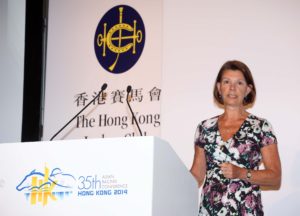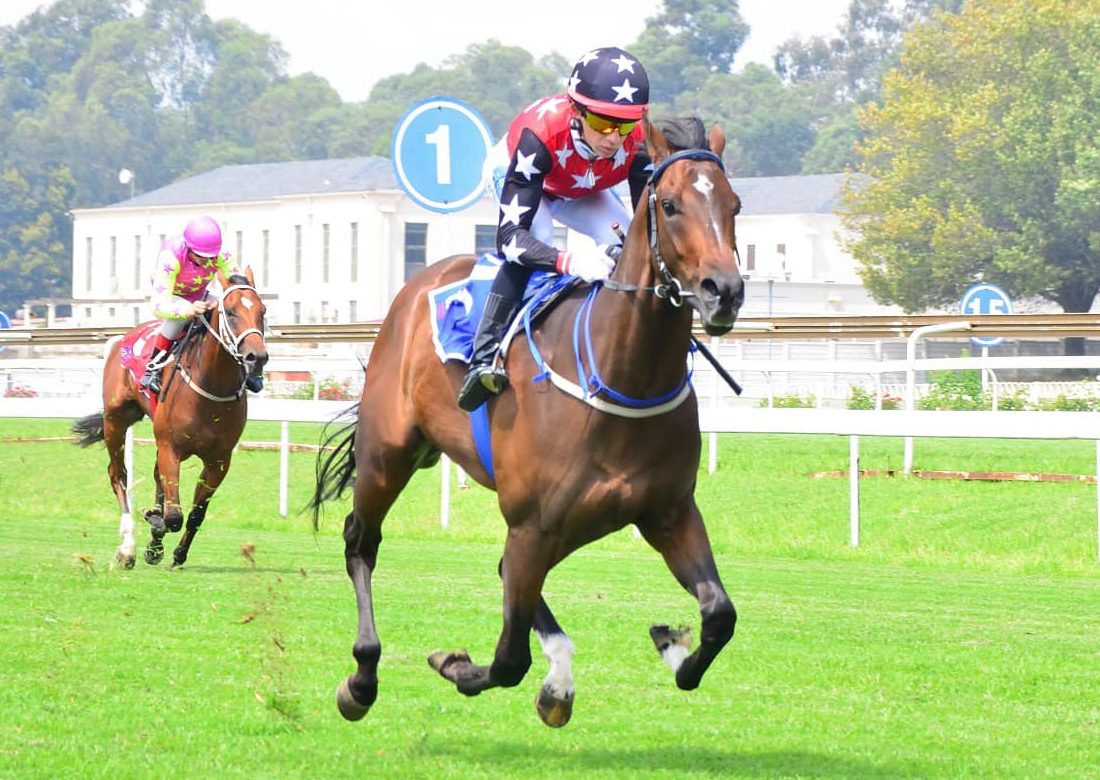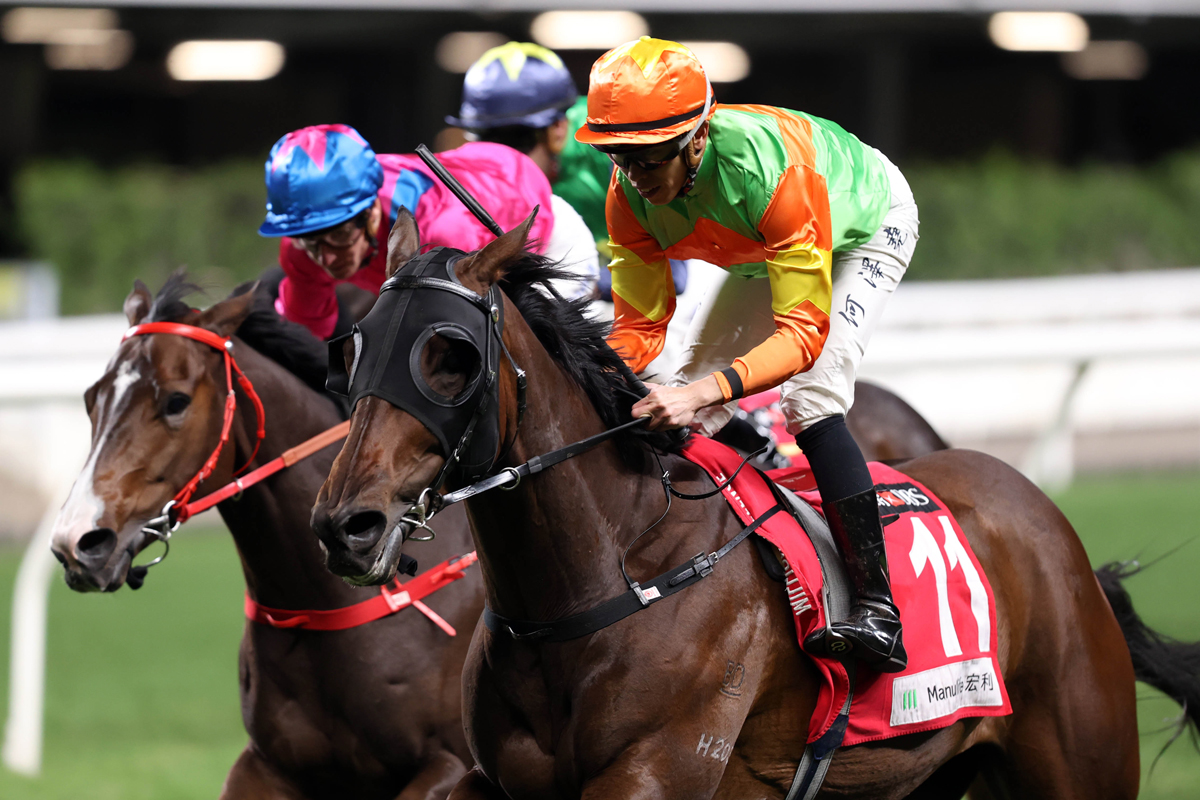The opening day of the Asian Racing Conference was a multifaceted one with presentations on wagering as racing’s lifeblood; the positive impact racing has on local communities; the current status of the international movement of horses and what more needs to be done; a look at the strict enforcement of the rules governing race day drugs; and the European Pattern Committee Chairman called for global uniformity on medication.
‘Racing’s Lifeblood – the future landscape for wagering’.
Winfried Engelbrecht-Bresges is the CEO of the Hong Kong Jockey Club and chaired the first session of the three-day convocation, opening the 35th Asian Racing Conference with his keynote presentation. Mr Engelbrecht-Bresges, who is also Vice Chairman of both the Asian Racing Federation (ARF) and the International Federation of Horseracing Authorities (IFHA), pointed out the differences between horseracing and other major sports, which gain their revenues from sponsorship, merchandising, broadcast rights and event-day contributions. He stated that racing brings in only about 15% of its revenue from those streams enjoyed by other sports, while on average 65% of racing’s revenue comes from wagering.
Mr Engelbrecht-Bresges told delegates: “Wagering revenue is the lifeblood of racing. If we want to have a sustainable business model, if we want to make sure our sport is competitive, we have to grow our wagering income.”
“We have to invest heavily in racecourse facilities to meet customer demands; we have to invest in customer services, in marketing programmes and technology in light of the significant increased competition we face. We have to realise we are not only competing in a wagering market, in the end we are in the entertainment market. We are competing for the attention, time and entertainment dollar of our current and future customers,” he said, before observing that “racing is losing market share in the global gaming market and as a result becoming less relevant not only to customers but to independently run wagering operators.”
With race betting set to remain flat through to 2017 and sports betting turnover set to exceed that of horseracing for the first time this year, Mr Engelbrecht-Bresges forwarded two major factors “critical” to the development of the racing industry: “regulatory environment and governance” and “value creation”.
“Racing providers have to be aware that we have to conduct our sport on the basis of fair competition and integrity,” he said. “We have to ensure that issues like animal welfare and substance-free racing, not only regionally but on a global basis, have to be addressed and that we don’t have any fundamental issues with what I would like to call the hygiene factors. It’s an absolute must for customer confidence and for acceptance of our sport, especially among the younger customers. Furthermore for stakeholders, like sponsors and governments, they don’t want to see these issues.”
He outlined three main areas for the sport’s organisers to address: “We have to create an attractive value proposition, for people and owners to invest in the sport,” he said “Then we have to provide world-class racing sport entertainment, which is an essential value proposition if we are to grow the interest in the sport; to grow the customer base, especially among those who have a wagering propensity. Thirdly we have to design the racing product in relation to the fixtures, race programme, field size, quality of the sport and fairness of the competition to maximize the wagering potential.”
Mr Engelbrecht-Bresges also reminded delegates that IP (intellectual property) and copyrights must be protected as “the content we create and produce is our major asset.” He also shared the HKJC’s vertically integrated model, which controls all aspects of the industry, and eventually enabled the Club to initiate changes to revitalise racing and to create relevance to customers, which as a result created a significant increase in income. He said that in-depth customer analysis had identified eight different customer segments, and, after looking at customer behaviour holistically, the Club is tailoring the racing experience to those groups.
“We know that our customer base is not monolithic and that we have different customer segments who have different needs and who process information differently,” said Mr Englebrecht-Bresges. “We need a more outside in look than an inside out look.”
In the face of outside competition, particularly from illegal market and casinos, Mr Engelbrecht-Bresged noted that between 2006 and 2009 the Hong Kong Jockey Club launched a rebate scheme for bigger bets, to address the challenge from the illegal and offshore operators in terms of pricing. And in 2009/10, he told delegates, “we increased our supply by increasing our racedays from 78 to 83, which produced an increase in turnover of 13%.”
In the last four years, said Mr Engelbrecht-Bresges, thanks to the HK$3.5 billion invested since 2009 in the Racecourse Master Plan, a far-reaching redevelopment of racecourse facilities, the implementation of a customer segmentation programme and the engagement with integrated new technology for greater customer connectivity and participation, turnover has increased by 41%.
“Without the vertical integration, the task becomes difficult,” he acknowledged. “In those environments where there is no vertical integration, I would strongly recommend a different approach to connect and collaborate between racing and wagering operators to achieve similar results. The connectivity should provide the synergy in customer analytics and data sharing, to gain a deep understanding of the wagering needs of customers to create an optimal racing product ranging from field size, quality and competitiveness of the racing product itself and racing integrity.”
Jennifer Owen, an independent consultant to the gambling industry who has researched and analysed the gaming market since 1996, delivered the findings of her landmark study titled ‘The Future Landscape for Wagering: Market Analysis and Implications’. Ms Owen noted: “In many markets to date, and increasingly into the future, racing has become disconnected from wagering. Racing is a price-taker for its product but has lost control of the distribution.” She suggested that a direct financial linkage needs to be built between racing and betting in every market to incentivise innovation and growth, regardless of the ownership model. In emphasising the need for racing to engage a younger and wider customer base, Ms Owen also drew attention to various current trends attendant to horserace gaming within the six major jurisdictions (Japan, Hong Kong, USA, UK, Australia and France), one being the notable need to innovate in the face of technological advancements. The rise in the use of mobile devices for placing bets was forwarded as one significant trend. “Digital is the new shop front,” she said.
Breon Corcoran, Betfair CEO, highlighted the significant journey of growth that his company has been on since facilitating the first wagers between customers in 2000.
One of the recent international highlights has been the purchase of TVG in America, which broadcasts high definition racing coverage into 30 million homes across the country.
Under Betfair’s ownership, TVG has now become the leading online betting operator in the USA and has also recently concluded a commingling deal with the HKJC, allowing American customers to bet into the Hong Kong pools and watch Hong Kong racing.
Paul Bittar, CEO of the British Horseracing Authority highlighted the significant challenges faced by a racing jurisdiction that has the most heavily deregulated betting industry in the world, combined with an industry that, compared with the Hong Kong model, is “non-vertically integrated”. He said that this means that the BHA has a tough job to ensure that those who provide the racing product get a fair return for their contribution. On a more optimistic note, Mr Bittar mentioned that there is now a realistic prospect in the UK of a genuine commercial replacement to the Levy system of funding, which has changed very little since the 1960s. “We are looking to get into a position in which the government has no direct involvement in the funding of racing.
Phillipe Germond, Chairman and CEO of France’s PMU highlighted how his organisation has reacted to the changing wagering market in France, and particularly to its loss of the monopoly on online betting in the country. The PMU has taken this as an opportunity and is now the second largest online sports bookmaker in France, and third for online poker. “This has given us the opportunity to cross-sell racing to these new sports and poker customers,” said Mr Germond. The PMU has also sought to increase international partnerships, in terms of both import and export of picture rights and associated benefits for turnover. There is a challenging economic situation in France and for the PMU this means a requirement to invest significantly in its business and to be extremely customer-centric. Germonde said: “We either innovate or face continual decline.”
David Attenborough, the head of Tabcorp in Australia discussed the challenges that legal onshore corporate bookmakers are posing to the business, as taxation legislation gives them the chance to offer tote products at a much lower margin than Tabcorp. Tabcorp currently returns 8.9% of its turnover on racing back to the sport – for the bookmakers that figure drops to 1.8%, giving the latter a big advantage. Mr Attenborough told the delegates that Tabcorp is now investing heavily in three key areas, which he categorised as: Customer; Channel; and Product.
Horseracing: A positive community impact
The Honourable Matthew Cheung is the Secretary for Labour and Welfare of the Hong Kong Special Administrative Region. At the ARC’s plenary session examining ‘The Community Impact’ of horseracing, Mr Cheung delivered a presentation entitled ‘The Role of the Hong Kong Jockey Club in Building a Caring Society’ emphasising the HKJC’s instrumental role in “augmenting, supplementing and complementing the government’s efforts in building a more caring compassionate and cohesive society.” Highlighting the rapid social changes that are occurring in Hong Kong, particularly the demographic concerns regarding their aging population, Mr Cheung drew attention to HKJC’s close collaboration with the government and the non-governmental organisation (NGO) sector in working to devise long-term solutions to evolving welfare demands.
Government expenditure on social welfare is set to reach HK$57 billion in 2014/15, which represents 18.5% of the Hong Kong government’s total recurrent expenditure.
Mr Cheung applauded the Jockey Club Charities Trust, which has donated an average of over HK$1.3 billion to the community on an annual basis for the past decade.
Their donations have supported the projects of over 100 charitable groups and organisations each year, including community services, education and training, health, culture and sports. Mr Cheung remarked that “It is no exaggerating to say that the logo of the Hong Kong Jockey Club is omnipresent in Hong Kong.” The Jockey Club not only generates substantial and stable tax revenue for the government, it also creates job opportunities and serves as a major charitable benefactor. He said: “The Hong Kong Jockey Club has weaved itself into the local social fabric and has established itself as a beacon of charity and a key fountain of funding for worthy community projects in Hong Kong. The range and diversity of these projects amply reflects the Jockey Club’s commitment to contributing to this city’s long-term social development. In short, the Jockey Club is far more than a powerhouse of horse racing of international standing. It is an important social engine generating immense horse power to propel the long-term social development of Hong Kong.”
A keynote speech by the Honourable John Brumby, former Premier of the State of Victoria in Australia, outlined “racing’s capacity to make a significant contribution to public revenues, employment, economy and society” in his address entitled ‘Racing and Major Events: a Governmental Perspective’. “Globally the industry generates wagering turnover of 94 billion Euros and has total global attendances of more than 100 million a year.
“There is a horse race somewhere in the world every three minutes. Activity on this scale is a substantial economic enterprise, and the capacity of racing to generate significant public revenues is plainly of interest to Governments.”
He noted that in Japan, the Japan Racing Association contributes 10% of its turnover and half of any surplus profit, which in 2013 amounted to US$2.5 billion. In addition, the JRA generated US$57 million in 2011 to help the people and communities affected by the Japanese earthquake and tsunami. Mr Brumby also pointed out that in Hong Kong, the Jockey Club is the largest single taxpayer, responsible for 7.4% of fiscal receipts in 2012/13, and on top of this the HKJC made a total HK$1.95 billion contribution to charity in that year.
Turning his attention to the importance of major horseracing events to tourism, Mr Brumby noted that in 2012, the Melbourne Spring Carnival attracted an overall attendance of 706,840 people. “Of the 700,000 attendees, almost one in four were from interstate or overseas and many of these people travelled to Melbourne solely for the event; the same tourism impact from racing can also be seen in other countries. In Vintage Crop’s country of origin, an estimated 80,000 people a year travel to Ireland to go racing. Here in Hong Kong, a Wednesday night at Happy Valley is a major tourist drawcard,” he said. In conclusion, the former premier of Victoria suggested that “it has always been my view that a prosperous and responsible racing industry is an important element of civil society. If I am asked to sum up its community impact I would say it is overwhelmingly a beneficial one.
Michael Lynch CBE, CEO of West Kowloon District Cultural Authority, and one of the world’s pre-eminent arts administrators, endorsed Brumby’s view, saying:
“The connection between the arts and racing is fundamental. In many ways, the greatest audiences on the earth are at the racetrack, and racing and the arts have so much in common – we tell stories, we connect with audiences and we attempt to connect to society in meaningful ways. I’m full of admiration for the Hong Kong model that does all of this, but at the same time makes such a huge difference to the community.”
Chairing the six part session, Dr Koji Sato, the Asian Racing Federation Chairman, said that it is important for different sectors to “collaborate in a force for good for racing.” He said that “there is a strong need to coordinate and discuss conflicting and divergent views and this goal must be assumed by us, the racing operators and racing authorities.”
Dr Alan Jackson, a highly successful international management consultant and businessman, who has also held several positions of authority in the racing world, delivered a presentation entitled ‘A Possible Model to Generate Economic Surplus’. Dr Jackson challenged the industry to think about four points that may help racing going forward: “First develop a premier competition supported by appropriate feeder or secondary competitions; even up the competition to ensure exciting contests, financial stability, interest, participation both in the wagering direction and the spectator consumer direction; adapt the presentation to build audience, to build participation and loyalty; and finally, develop governance structures that allow the sport to make the hard decisions.”
‘Significant progress’ in international movement of horses
During a session titled: ‘Movement of Horses’, delegates were told that significant progress had been made to facilitate the internationalisation of racing and that good science, cooperation, harmonisation of protocols and developing trust were the keys to further progress.
Dr Brian Stewart, the Head of Equine Welfare and Veterinary Services at Racing Victoria in Australia, told delegates that the continued rise of international competition in horse racing is of significant importance, both for the sport itself, and for the venues and the regions that host racing’s major events. As an example, he noted that Melbourne’s Spring Carnival is now worth over A$600 million to the State of Victoria and that international participation had been credited with revitalising the event over recent years.
Stewart, also Chairman of the IMHC (International Movement of Horses Committee), said that although travelling racehorses to Australia was a major undertaking, the country had made a great deal of progress in easing travel restrictions, including significant Post Entry Quarantine and Post Arrival Quarantine changes in 2013.
He added that the reduction of the quarantine period for arriving overseas horses from three weeks to two weeks was clearly more attractive to international participants, and that further changes in stabling arrangements and the timing of equine influenza vaccinations had also helped. In addition, Dr Stewart reinforced the point that for progress to continue, it was vital that racing authorities understood the role and the priorities of relevant Government agencies, and worked collaboratively in the interests of the industry and the nation itself.
“Movement protocols are controlled by national government authorities who are inherently conservative and risk averse. We cannot simply wish for change nor can we force it. We must develop trusting relationships with the government authorities on a science based approach, and the concessions we have achieved in Australia have come about as a consequence of those two things, science and trust,” Dr Stewart said.
Dr Susanne Munstermann, Chargee de Mission of the OIE (World Organisation for Animal Health), outlined the concept of the HHP – high health, high performance horse – which could be defined as a sub-population of the global equine population and ought to be assessed differently from the wider population. “Horses under close veterinary supervision, such as those governed by the IFHA (International Federation of Horseracing Authorities), present a low health risk when traveled. They are identified and traceable and they enter countries on a temporary basis for competition, not for breeding.”
She also noted the perceived challenges to international travel in outlining the OIE’s proposal on the facilitation of international horse movement which calls for collaboration with the high performance horse bodies. Of particular significance was the partnership between the IFHA and the FEI (International Equestrian Federation), resulting in the formation of the International Horse Sports Confederation, to formalise co-operation between the world’s leading governing bodies for equestrian sport.
“Racing and equestrian sports bodies must emphasise to governments the socio-economic benefits of expanding HHP horses industries,” Dr Munstermann said.
Echoing Dr Stewart’s view that increased movement of horses internationally was vital to the growth of the multi-billion dollar horse racing industry were representatives of two other major racing nations. Dr Anthony Kettle, Head of the Veterinary Department of the Dubai Racing Club, supported the HHP proposal, describing it as ‘a vehicle to solve the current problems hampering growth in the horse racing industry.’ “”The equine industry and government veterinary services must work together,” said Dr Kettle who emphasised the need to write a set of harmonised conditions in a multi-billion dollar industry.
Peter Gibson, CEO of Racing South Africa, called on the world’s horse importing countries to revisit their import conditions and negotiate new terms with the South African veterinary authority. “We call on our fellow horse racing nations to rally behind our cause,” said Gibson, who pointed to further ‘risk mitigating’ components being implemented in South African quarantine procedures. “Internationalisation is the key to stimulating South African racing,” Gibson said.
Dr Stewart summed up as follows: “We are at a point in time where we have the significant opportunity of achieving change and harmonisation. The involvement of the OIE is a great partnership which can raise awareness and build confidence. ‘There are further benefits to come from harmonisation and significant potential for change, especially in developing countries.”
Racing Authorities to enforce stringent drug rules
Mr Louis Romanet, Chairman of the International Federation of Horseracing Authorities (IFHA) reaffirmed his organisation’s commitment to horse welfare and medication control at the session titled ‘Fair Competition and Drug Control.‘ Romanet spoke of the IFHA’s commitment to both issues during the session, which also featured a presentation from world sports medicine expert Dr Perikles Simon, under the heading ‘Leveling the Doping Field‘.
“The IFHA must be proactive. The integrity of racing and horse welfare are absolute priorities” Romanet said before detailing two significant elements of IFHA policy which he said had been universally endorsed. “The first is agreement on control of medications including international screening limits and detection times. The second is a commitment to the detection of doping agents and prohibited practices in and out of competition.
The IFHA supports a total ban on raceday medication and bans on anabolic agents throughout a horse’s career.
Delegates heard that it is vital to the credibility of horse racing that everything is done to keep the sport ‘clean’ and retain the confidence of its participants, its fans and, crucially for racing’s finances, those who wager on horseracing – while noting that racing is far from the only sport facing this issue.
Dr Simon, from Johannes Gutenberg University in Germany, is a sports medicine and molecular biologist who is at the cutting edge of the fight against doping in sport. He was one of the original seven-member ‘Gene Doping’ group of experts within the World Anti-Doping Agency (WADA), charged with developing strategies for the prevention and detection of non-therapeutic use of gene protein in sport. Dr Simon said that he was confident science could win the war against drugs provided other factors could be overcome. “While there may well be some drugs or combinations of drugs and methods of which the anti-doping community is unaware, the science now available is both robust and reliable. The real problems are human and political factors,” he said, noting that total revenue generated by elite sports dwarfed the amount spent on new detection procedures.
Presentations were also made by: Dr Yves Bonnaire, General Manager of the French Racing Laboratory, who gave an update on prohibited substances; Dr Seungho Ryu, International Racing Manager of the Korea Racing Authority, who outlined drug control in Korea; and Dr Paul Marie Gadot, Head of the Horses and Control Department of France Galop, whose subject was immunocastration and regularity of racing.
In a discussion which concluded this session. Mr James Gagliano, President and Chief Operating Officer of The Jockey Club was questioned about the situation in America. Mr Gagliano said: “Recent events have further galvanised our spirit to improve in all areas. The industry requires consumer confidence and trust and the welfare of the horse is a high priority,” he said.
European Pattern Committee Chairman says global uniformity on medication needed to protect the Pattern’s integrity
Brian Kavanagh, Chief Executive of Horseracing Ireland and Chairman of the European Pattern Committee called for uniform international rules relating to medication. “I believe that the IFHA (International Federation of Horseracing Authorities) must move to a single worldwide set of rules relating to medication and we simply must find a way of ensuring that these rules can be enforced in all member countries,” said Mr Kavanagh, who was speaking in the context of ensuring the integrity of the Longines World’s Best Racehorse Rankings, and, by extension, all Pattern races. “I realise that this is not straightforward in some countries,” he said, “but in order to have value and integrity for our global rankings and our black type system in sales catalogues, it is simply where we must go.” A live electronic poll of delegates attending the session revealed that 82 per cent were in favour of standard medication rules being linked to the Pattern system.
Mr Kavanagh’s presentation, during the session titled: ‘The Pattern: Now and in the Future‘, outlined the development of the Pattern race system since its conception in England in the 1960s and its initial implementation in 1971 under the administration of the European Pattern Committee. He told those in attendance that the European Pattern’s pyramid structure achieves a balance in protecting the quality of races, with the total number of Group 3 races exceeding the number of Group 2 and Group 1 races combined, and Group 2 races outnumbering Group 1 contests.
Noting the marked increase in international competition over the past two decades, Mr Kavanagh highlighted that one of the fundamental aims of the IFHA is “the organisation of competitions to select the best horses in order to improve the quality of breeding.” He posed the question: “In this new global framework, how do we identify the best horses and the best races?” He said: “Our Pattern systems and our sales cataloguing systems need to adapt to reflect our global business,” and noted that “there are too many races in the world carrying a grading which would not be justified under a single global ranking system.”
Mr Kavanagh pointed out that the ranking system has evolved internationally so that today a group of handicappers from 20 countries assess horses around the world and agree on ratings. “The rankings are now published 10 times a year, which means that horse racing has a vehicle to promote the global rankings of its elite performers, the same as for other sports such as tennis, golf and Formula One,” he said, calling the Longines World’s Best Racehorse Rankings “a powerful marketing tool” on a global scale.
Mr Kavanagh told delegates that in 2013, 146,649 Flat races were run worldwide with 3.3% of those classified as Pattern races (4,889), 1.3% as Graded/Group races (1,895) and 0.3% as Grade/Group 1 races (459). “These statistics suggest that there are not too many graded races in the world,” he said, while acknowledging that “the number of non-graded black type (Listed) races, which is more than double the number of graded races, may need consideration. A system of quality control is very important and this is done regionally at the moment.”
Mr Kavanagh also noted the innovative developments of major race days in recent years, such as British Champions Day, Irish Champions Weekend and The Championships in Australia, along with the Prix de l’Arc de Triomphe meeting and the Breeders’ Cup. He said that he believes the Pattern system accommodates these events appropriately.
“The Pattern is a regulatory mechanism, so it should seek respect rather than popularity.”
“It is very encouraging to see an increased desire amongst race clubs worldwide to upgrade the standard and value of their races and I believe that the Pattern systems worldwide have proven themselves well capable of accommodating such requests while ensuring that racing is developed in a structured fashion.” He cited the success of the decision 10 years ago to extend the Pattern programme for older fillies and mares in Europe, and said that the European sprint programme could be next to experience a revamp.
“The European Pattern Committee has identified the sprint programme as an area of weakness and that is obvious to anyone who has looked at the World Rankings in recent years. There are a number of shortcomings in the sprint programme and it is significant that Ireland’s leading sprinter Sole Power has had his last 22 races overseas. We hope to recommend changes to ensure that better quality sprinters can be put in training and retained in training in Europe,” he said. “The Committee expects to conclude its work in this area by the middle of this year.”
“The European Pattern Committee exercises strict quality control over European racing. In recent years, the Committee has tightened its rules and made more downgrades than upgrades. Next year, a total of 46 races, including a number of Group 1 races, will be reviewed by the Committee, representing more than 10% of Group races run in Europe.”
Regarding the case for Super Group 1 races, Mr Kavanagh commented: “We get asked why we don’t identify a subset of races which reflect the elite races worldwide. While that is understandable, it would create practical difficulties. The Committee believes the focus should be on the world’s elite horses instead.”
Mr William A Nader, the Hong Kong Jockey Club’s Executive Director of Racing, chaired this plenary session and aired his support for Super Group 1 races. He commented: “I think it is a good idea because there are 459 Group 1 races which is a big number. If you look at other sports and see how many tennis and golf tournaments there might be, we know which ones are the big occasions. We certainly know that in racing too and it is a question of recognising the elite races. Certainly, the 459 are not equal (in terms of quality) – we all know that. So it would good to recognise Super Group 1s, until we can really get the house in order by bring the number of Group 1s down by 10% or 20% over time. Whether we highlight 20, 50 or 100 races, we have a pretty good idea which ones those are and I believe they should be recognised.” A majority of the ARC delegates in the Grand Hall of the Hong Kong Convention Centre agreed with him, with a live vote producing 59.6% in favour of the creation of Super Group 1s and 40.4% against.
The South African programme for the 2012/13 season, included 33 Group 1 races, 37 Group 2’s , 48 Group 3 and 74 Listed races.
Mr Nader, in his opening remarks, said: “The Pattern is an increasingly important part of our industry, as thoroughbred racing has rapidly evolved into a global sport.
Today, more than ever, the quality control process in the grading and governance of major races must be rock solid, with consistency and credibility. These are basic requirements if horse racing is going to be taken seriously as an international sport.
If you look at a one-page snapshot – country by country – of the number of Group 1 races as it stands today, it makes no sense. But it cannot be changed overnight. We are moving in the right direction but there is clearly an imbalance. We are taking steps within the Asian Pattern Committee to carefully review races as regards to upgrades and downgrades. South America accounts for 20% of the world’s Graded races, and to its credit, is taking proactive steps to address issues with quality control. In the end, a global balance needs to be reached. A very small percentage of the world’s races are Graded but we need to make sure, to the best of our ability using systematic methodology, that we get those races right.”
The session also featured a presentation on ‘the Strategy for the Development of Racing and Breeding in Saudi Arabia’, given by Adel Almazroa, General Manager of the Equestrian Club of Riyadh, who pointed out the growth of racing and breeding in Saudi Arabia. The number of foals born in 2013 was 1,473 as against 723 10 years previously, while there are also more races and higher prize money. To boost quality, a number of import criteria were introduced two years ago and the average rating has improved. There is now a three-year plan to boost quality further.


